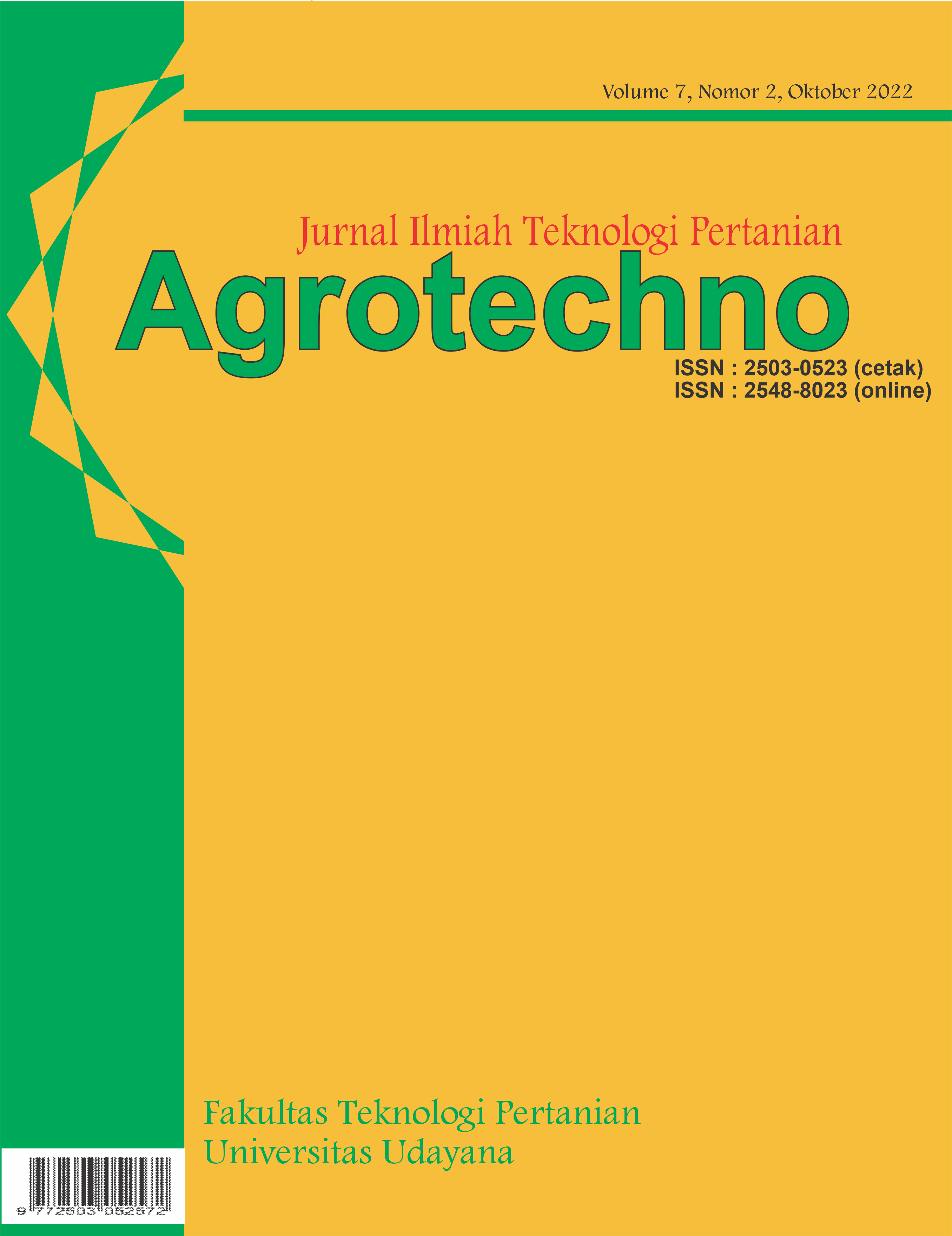Potensi Beberapa Sayuran Indigenous Bali sebagai Pangan Fungsional
Abstract
Vegetables are a source of dietary fiber, minerals, vitamins and antioxidants which are very important for health. The purpose of this study was to obtain the characteristics of the chemical components and bioactive compounds of several local indigenous Balinese vegetables (Kejompot leaf, Banana stem, Pumpkin leaf, and Gonda) in an effort to use them as functional food. The study was conducted using a completely randomized design (CRD) with the treatment of vegetable types and was repeated 4 times. Data were analyzed descriptively and presented in the form of tables and graphs. Parameters observed included: dietary fiber, water content, levels of Ca, Fe, Zn, total phenol, total flavonoid, vitamin C, and antioxidant activity. The results showed that local indigenous Balinese vegetables have the potential as functional food, especially Kejompot which contains higher bioactive components and antioxidant activity than other vegetables.
Downloads
References
Adjatin, A., Dansi, A., Badoussi, E., Sanoussi, A., Dansi, M., Azokpota, P., Ahissou, H., Akouegninou, A., Akpagana, K., & Sanni, A. (2013). Proximate, mineral and vitamin C composition of vegetable Gbolo [Crassocephalum rubens (Juss. ex Jacq.) S. Moore and C. crepidioides (Benth.) S. Moore] in Benin. International Journal of Biological and Chemical Sciences, 7(1), 319. https://doi.org/10.4314/ijbcs.v7i1.27
Aguilar-Garcia, C., Gavino, G., Baragaño-Mosqueda, M., Hevia, P., & Gavino, V. C. (2007). Correlation of tocopherol, tocotrienol, γ-oryzanol and total polyphenol content in rice bran with different antioxidant capacity assays. Food Chemistry, 102(4), 1228–1232. https://doi.org/10.1016/j.foodchem.2006.07.012
Arasaretnam, S., Kiruthika, A., & Mahendran, T. (2018). Nutritional and mineral composition of selected green leafy vegetables. Ceylon Journal of Science, 47(1), 35. https://doi.org/10.4038/cjs.v47i1.7484
Dhingra, D., Michael, M., Rajput, H., & Patil, R. T. (2012). Dietary fibre in foods: A review. Journal of Food Science and Technology, 49(3), 255–266. https://doi.org/10.1007/s13197-011-0365-5
Josipovic, A., Sudar, R., Sudaric, A., Jurkovic, V., Matosa Kocar, M., & Markulj Kulundzic, A. (2016). Total phenolic and total flavonoid content variability of soybean genotypes in eastern Croatia. Croatian Journal of Food Science and Technology, 8(2), 60–65. https://doi.org/10.17508/cjfst.2016.8.2.04
Lattimer, J. M., & Haub, M. D. (2010). Effects of dietary fiber and its components on metabolic health. Nutrients, 2(12), 1266–1289. https://doi.org/10.3390/nu2121266
Mardiyani, S. A., Malang, U. I., & Khoiriyah, N. (2017). Kajian morfologis dan fungsional 5 sayuran indigenous minor sebagai sumber nutrisi berbasis kearifan lokal di wilayah Malang Raya. July.
Mohd, A., Idris, M., & Abdulrasheed, A. (2016). The mineral composition and proximate analysis of T. occidentalis (Fluted Pumpkin) leaves consumed in Kano Metropolis, Northern Nigeria. American Chemical Science Journal, 10(1), 1–4. https://doi.org/10.9734/acsj/2016/20632
Nikolic, N., Borisev, M., Pajevic, S., Arsenov, D., & Zupunski, M. (2014). Comparative assessment of mineral elements and heavy metals accumulation in vegetable species. Food and Feed Research, 41(2), 115–123. https://doi.org/10.5937/ffr1402115n
Oloyede, F. M. (2012). Growth, yield and antioxidant profile of pumpkin (Cucurbita pepo L.) leafy vegetable as affected by NPK compound fertilizer. Journal of Soil Science and Plant Nutrition, 12(3), 379–387. https://doi.org/10.4067/s0718-95162012005000001
Papoutsis, K., Vuong, Q. V., Pristijono, P., Golding, J. B., Bowyer, M. C., Scarlett, C. J., & Stathopoulos, C. E. (2016). Enhancing the total phenolic content and antioxidants of lemon pomace aqueous extracts by applying uv-c irradiation to the dried powder. Foods, 5(3), 1–10. https://doi.org/10.3390/foods5030055
Putrasamedja, S. (2005). Eksplorasi dan koleksi sayuran indigenous di Kabupaten Karawang, Purwakarta, dan Subang. Jurnal Buletin Plasma Nutfah, 11(1), 16–20.
Rochana, A., Dhalika, T., Budiman, A., & Kamil, K. A. (2017). Nutritional value of a banana stem (Musa paradisiaca val) of anaerobic fermentation product supplemented with nitrogen, sulphur and phosphorus sources. Pakistan Journal of Nutrition, 16(10), 738–742. https://doi.org/10.3923/pjn.2017.738.742
Said, K. A. M., Radzi, Z., Yakub, I., & Amin, M. A. M. (2016). Extraction and quantitative determination of ascorbic acid from banana peel Musa Acuminata “Kepok.” IIUM Engineering Journal, 17(1), 103–114. https://doi.org/10.31436/iiumej.v17i1.576
Shah, P., & Modi, H. A. (2015). Comparative study of DPPH, ABTS and FRAP assays for determination of antioxidant activity. International Journal for Research in Applied Science & Engineering Technology (IJRASET), 3(6), 636–641. www.ijraset.com
Shetty, A. A., Magadum, S., & Managanvi, K. (2013). Vegetables as sources of antioxidants. Journal of Food & Nutritional Disorders, 02(01), 1–5. https://doi.org/10.4172/2324-9323.1000104
Škerget, M., Kotnik, P., Hadolin, M., Hraš, A. R., Simonič, M., & Knez, Ž. (2005). Phenols, proanthocyanidins, flavones and flavonols in some plant materials and their antioxidant activities. Food Chemistry, 89(2), 191–198. https://doi.org/10.1016/j.foodchem.2004.02.025
Soetiarso, T.(BALITSA). (2015). Sayuran Indigenous alternatif sumber pangan bernilai gizi tinggi. Iptek Hortikultura, 5(3), 10–16.
Suryaningsih, S., Said, I., & Rahman, N. (2018). Analisis Kadar Kalsium (Ca) dan Besi (Fe) dalam Kangkung Air (Ipomeae aquatica forsk) dan Kangkung Darat (Ipomeae reptan forsk) Asal Palu. Jurnal Akademika Kimia, 7(3), 130. https://doi.org/10.22487/j24775185.2018.v7.i3.11908
Widarta, I. W. R., & Arnata, I. W. (2017). Ekstraksi komponen bioaktif daun alpukat dengan bantuan ultrasonik pada berbagai jenis dan konsentrasi pelarut. Agritech, 37(2), 148–157. https://doi.org/http://doi.org/10.22146/agritech.10397
Widarta, I. W. R., & Wiadnyani, A. A. I. S. (2019). Pengaruh metode pengeringan terhadap aktivitas antioksidan daun alpukat. Jurnal Aplikasi Teknologi Pangan, 8(3), 80–85. https://doi.org/10.17728/jatp.3361










